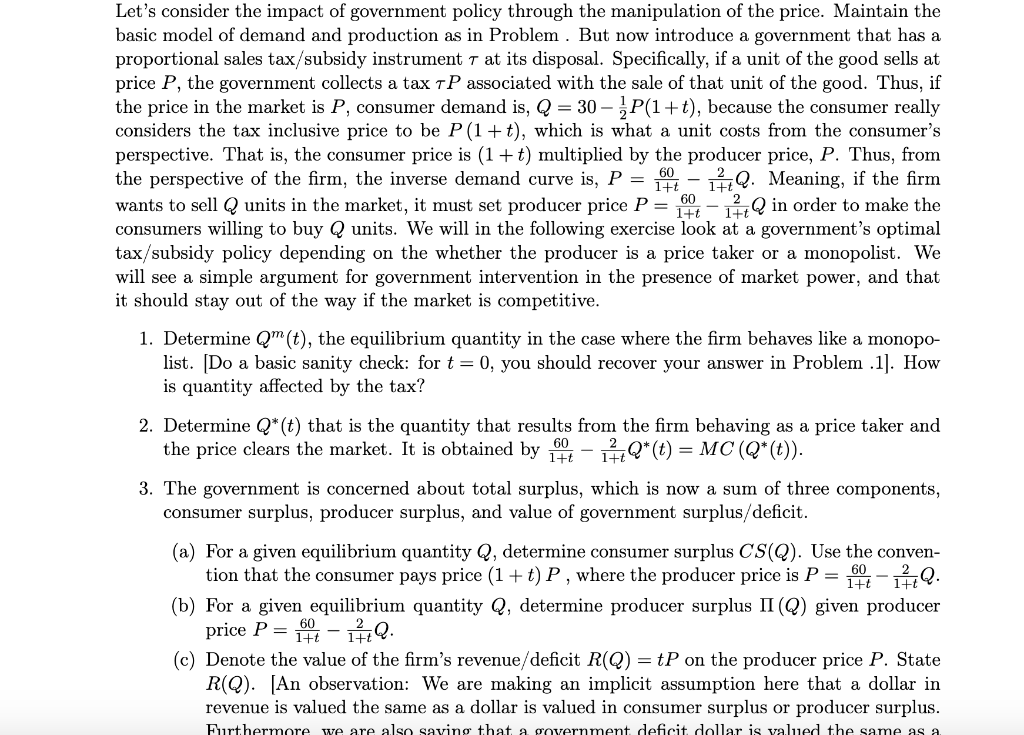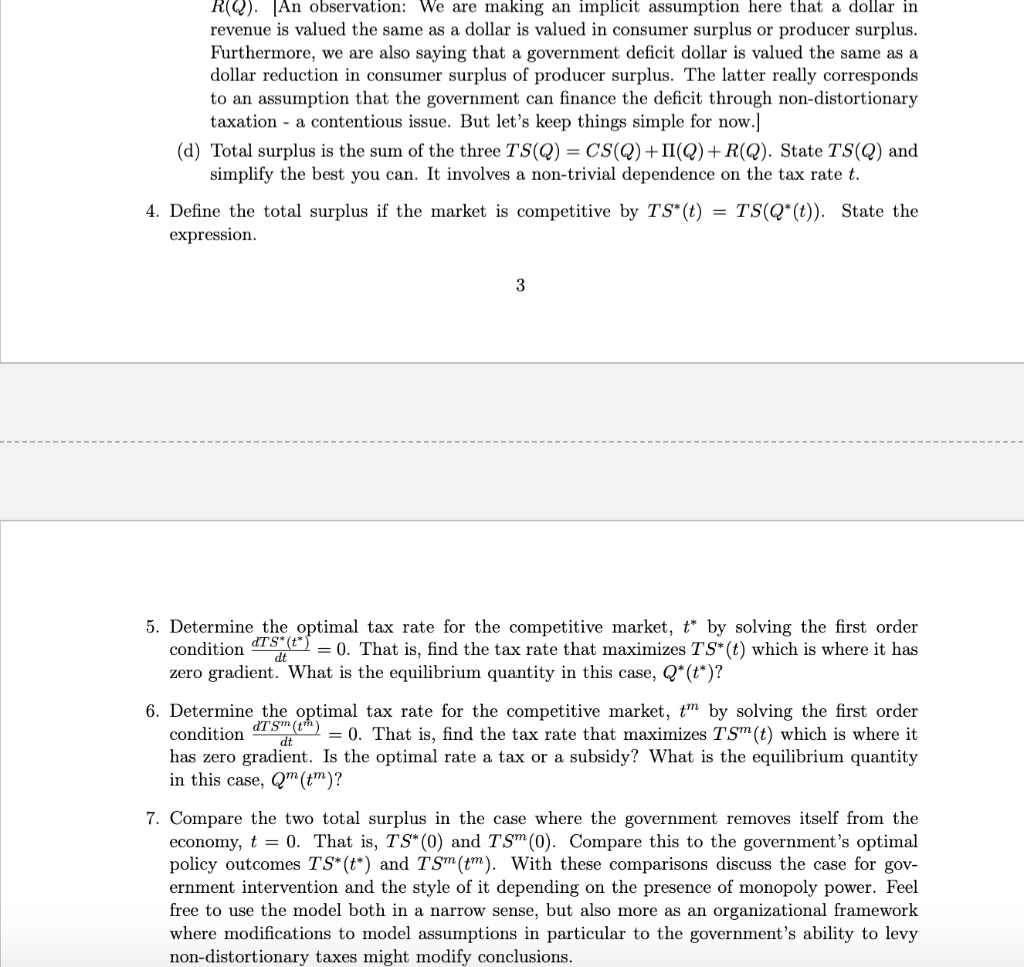

60 Let's consider the impact of government policy through the manipulation of the price. Maintain the basic model of demand and production as in Problem . But now introduce a government that has a proportional sales tax/subsidy instrument at its disposal. Specifically, if a unit of the good sells at price P, the government collects a tax TP associated with the sale of that unit of the good. Thus, if the price in the market is P, consumer demand is, Q = 30 P(1+t), because the consumer really considers the tax inclusive price to be P(1+t), which is what a unit costs from the consumer's perspective. That is, the consumer price is (1 +t) multiplied by the producer price, P. Thus, from the perspective of the firm, the inverse demand curve is, P = 1Q. Meaning, if the firm wants to sell Q units in the market, it must set producer price P= 1+t - ThQ in order to make the consumers willing to buy Q units. We will in the following exercise look at a government's optimal tax/subsidy policy depending on the whether the producer is a price taker or a monopolist. We will see a simple argument for government intervention in the presence of market power, and that it should stay out of the way if the market is competitive. 1. Determine Qm(t), the equilibrium quantity in the case where the firm behaves like a monopo- list. [Do a basic sanity check: for t = 0, you should recover your answer in Problem .1). How is quantity affected by the tax? 1+t = 2. Determine Q*(t) that is the quantity that results from the firm behaving as a price taker and the price clears the market. It is obtained by 10 - 144Q*(t) = MC(Q*(t)). 60 3. The government is concerned about total surplus, which is now a sum of three components, consumer surplus, producer surplus, and value of government surplus/deficit. (a) For a given equilibrium quantity Q, determine consumer surplus CS(Q). Use the conven- tion that the consumer pays price (1 +t) P, where the producer price is P = b - I Q. (b) For a given equilibrium quantity Q, determine producer surplus II (Q) given producer price P = 0 - Q. (c) Denote the value of the firm's revenue/deficit R(Q) = tP on the producer price P. State R(Q). [An observation: We are making an implicit assumption here that a dollar in revenue is valued the same as a dollar is valued in consumer surplus or producer surplus. = = Furthermore we are also saving that a government deficit dollar is valued the same as a R(Q). An observation: We are making an implicit assumption here that a dollar in revenue is valued the same as a dollar is valued in consumer surplus or producer surplus. Furthermore, we are also saying that a government deficit dollar is valued the same as a dollar reduction in consumer surplus of producer surplus. The latter really corresponds to an assumption that the government can finance the deficit through non-distortionary taxation - a contentious issue. But let's keep things simple for now. (d) Total surplus is the sum of the three TS(Q) = CS(Q)+II(Q)+R(Q). State TS(Q) and simplify the best you can. It involves a non-trivial dependence on the tax rate t. 4. Define the total surplus if the market is competitive by TS*(t) TS(Q*(t)). State the expression. = 3 dt 5. Determine the optimal tax rate for the competitive market, t* by solving the first order condition (t = 0. That is, find the tax rate that maximizes TS*(t) which is where it has zero gradient. What is the equilibrium quantity in this case, Q* (t*)? 6. Determine the optimal tax rate for the competitive market, tm by solving the first order condition dTsheh) = 0. That is, find the tax rate that maximizes T Sm (t) which is where it has zero gradient. Is the optimal rate a tax or a subsidy? What is the equilibrium quantity in this case, Q"(tm)? dt 7. Compare the two total surplus in the case where the government removes itself from the economy, t = 0. That is, TS*(0) and TSM(O). Compare this to the government's optimal policy outcomes TS*(t*) and TSM(tm). With these comparisons discuss the case for gov- ernment intervention and the style of it depending on the presence of monopoly power. Feel free to use the model both in a narrow sense, but also more as an organizational framework where modifications to model assumptions in particular to the government's ability to levy non-distortionary taxes might modify conclusions. 60 Let's consider the impact of government policy through the manipulation of the price. Maintain the basic model of demand and production as in Problem . But now introduce a government that has a proportional sales tax/subsidy instrument at its disposal. Specifically, if a unit of the good sells at price P, the government collects a tax TP associated with the sale of that unit of the good. Thus, if the price in the market is P, consumer demand is, Q = 30 P(1+t), because the consumer really considers the tax inclusive price to be P(1+t), which is what a unit costs from the consumer's perspective. That is, the consumer price is (1 +t) multiplied by the producer price, P. Thus, from the perspective of the firm, the inverse demand curve is, P = 1Q. Meaning, if the firm wants to sell Q units in the market, it must set producer price P= 1+t - ThQ in order to make the consumers willing to buy Q units. We will in the following exercise look at a government's optimal tax/subsidy policy depending on the whether the producer is a price taker or a monopolist. We will see a simple argument for government intervention in the presence of market power, and that it should stay out of the way if the market is competitive. 1. Determine Qm(t), the equilibrium quantity in the case where the firm behaves like a monopo- list. [Do a basic sanity check: for t = 0, you should recover your answer in Problem .1). How is quantity affected by the tax? 1+t = 2. Determine Q*(t) that is the quantity that results from the firm behaving as a price taker and the price clears the market. It is obtained by 10 - 144Q*(t) = MC(Q*(t)). 60 3. The government is concerned about total surplus, which is now a sum of three components, consumer surplus, producer surplus, and value of government surplus/deficit. (a) For a given equilibrium quantity Q, determine consumer surplus CS(Q). Use the conven- tion that the consumer pays price (1 +t) P, where the producer price is P = b - I Q. (b) For a given equilibrium quantity Q, determine producer surplus II (Q) given producer price P = 0 - Q. (c) Denote the value of the firm's revenue/deficit R(Q) = tP on the producer price P. State R(Q). [An observation: We are making an implicit assumption here that a dollar in revenue is valued the same as a dollar is valued in consumer surplus or producer surplus. = = Furthermore we are also saving that a government deficit dollar is valued the same as a R(Q). An observation: We are making an implicit assumption here that a dollar in revenue is valued the same as a dollar is valued in consumer surplus or producer surplus. Furthermore, we are also saying that a government deficit dollar is valued the same as a dollar reduction in consumer surplus of producer surplus. The latter really corresponds to an assumption that the government can finance the deficit through non-distortionary taxation - a contentious issue. But let's keep things simple for now. (d) Total surplus is the sum of the three TS(Q) = CS(Q)+II(Q)+R(Q). State TS(Q) and simplify the best you can. It involves a non-trivial dependence on the tax rate t. 4. Define the total surplus if the market is competitive by TS*(t) TS(Q*(t)). State the expression. = 3 dt 5. Determine the optimal tax rate for the competitive market, t* by solving the first order condition (t = 0. That is, find the tax rate that maximizes TS*(t) which is where it has zero gradient. What is the equilibrium quantity in this case, Q* (t*)? 6. Determine the optimal tax rate for the competitive market, tm by solving the first order condition dTsheh) = 0. That is, find the tax rate that maximizes T Sm (t) which is where it has zero gradient. Is the optimal rate a tax or a subsidy? What is the equilibrium quantity in this case, Q"(tm)? dt 7. Compare the two total surplus in the case where the government removes itself from the economy, t = 0. That is, TS*(0) and TSM(O). Compare this to the government's optimal policy outcomes TS*(t*) and TSM(tm). With these comparisons discuss the case for gov- ernment intervention and the style of it depending on the presence of monopoly power. Feel free to use the model both in a narrow sense, but also more as an organizational framework where modifications to model assumptions in particular to the government's ability to levy non-distortionary taxes might modify conclusions








